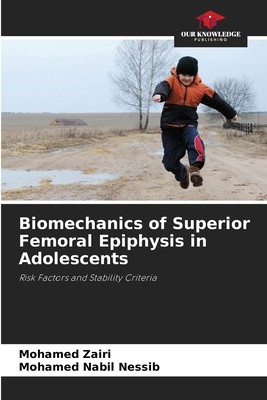
- We will send in 10–14 business days.
- Author: Mohamed Zairi
- Publisher: Our Knowledge Publishing
- ISBN-10: 6205255502
- ISBN-13: 9786205255506
- Format: 15.2 x 22.9 x 0.3 cm, softcover
- Language: English
- SAVE -10% with code: EXTRA
Biomechanics of Superior Femoral Epiphysis in Adolescents (e-book) (used book) | bookbook.eu
Reviews
Description
Introduction: The objectives of this study were to identify the biomechanical factors involved in the occurrence of upper femoral epiphysiolysis through a series of cases and a review of the literature and to study the biomechanical factors of stability of the upper femoral epiphysis after percutaneous screw fixation.Methods: This was a retrospective longitudinal study conducted in the orthopedic department at the Tunis Children's Hospital over a period of 7 years. The evaluation of the results was clinical by the PMA score and radiological by the calculation of the residual tilt angle. Results: The main biomechanical factor involved in the occurrence of EFS was obesity. It was identified in 58% of the cases with an adiposo-genital morphotype that represented 11%.Conclusion: Knowledge of the biomechanical factors at the time of placement of the cephalic screw is the guarantee of a stable osteosynthes
EXTRA 10 % discount with code: EXTRA
The promotion ends in 12d.16:40:13
The discount code is valid when purchasing from 10 €. Discounts do not stack.
- Author: Mohamed Zairi
- Publisher: Our Knowledge Publishing
- ISBN-10: 6205255502
- ISBN-13: 9786205255506
- Format: 15.2 x 22.9 x 0.3 cm, softcover
- Language: English English
Introduction: The objectives of this study were to identify the biomechanical factors involved in the occurrence of upper femoral epiphysiolysis through a series of cases and a review of the literature and to study the biomechanical factors of stability of the upper femoral epiphysis after percutaneous screw fixation.Methods: This was a retrospective longitudinal study conducted in the orthopedic department at the Tunis Children's Hospital over a period of 7 years. The evaluation of the results was clinical by the PMA score and radiological by the calculation of the residual tilt angle. Results: The main biomechanical factor involved in the occurrence of EFS was obesity. It was identified in 58% of the cases with an adiposo-genital morphotype that represented 11%.Conclusion: Knowledge of the biomechanical factors at the time of placement of the cephalic screw is the guarantee of a stable osteosynthes


Reviews